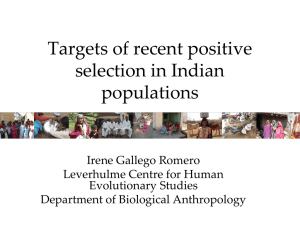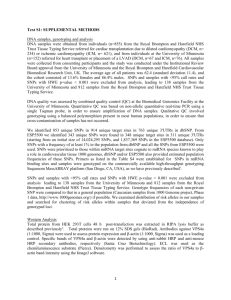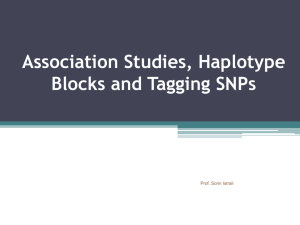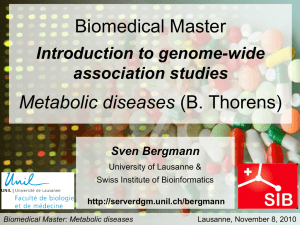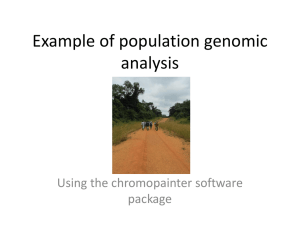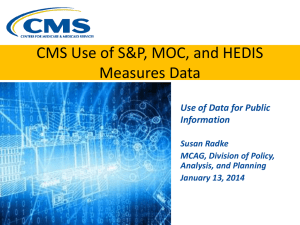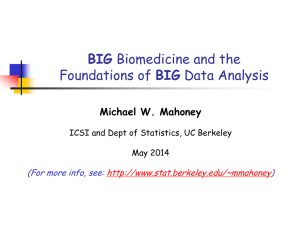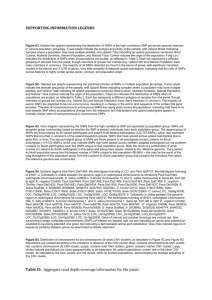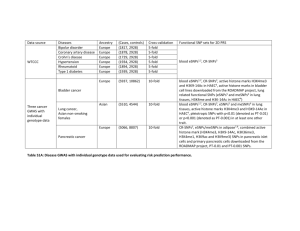Chatterjee_Banff2014Public
advertisement
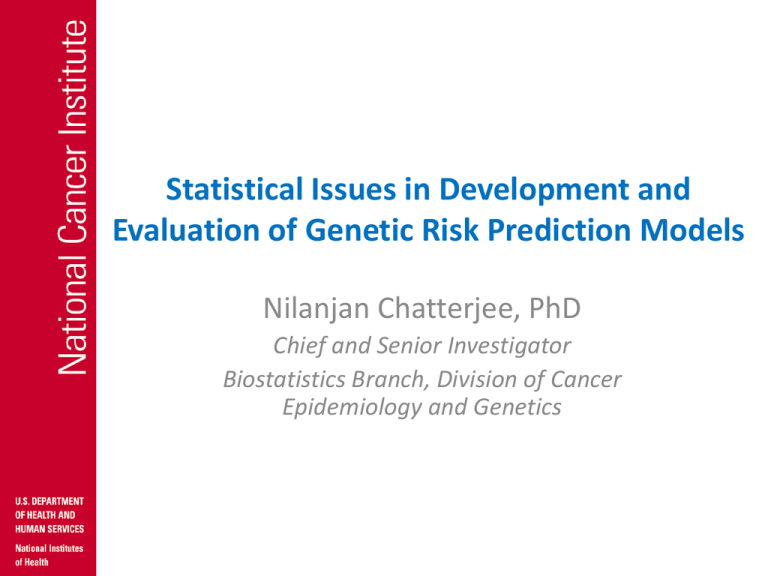
Statistical Issues in Development and Evaluation of Genetic Risk Prediction Models Nilanjan Chatterjee, PhD Chief and Senior Investigator Biostatistics Branch, Division of Cancer Epidemiology and Genetics Thanks to team science! Biostatistics Branch Other Institutions/Collaborations Peter Kraft, HSPH JuHyun Park, Fellow Montserrat Garcia-Closas, ICR, UK Paige Maas, Fellow Cambridge University, UK Jianxin Shi, TT Investigator German Cancer Research Center Joshua Sampson, TT Investigator BPC3 Consortium Bin Zhu, TT Investigator BCAC Consortium Mitchell Gail, Investigator Minsun Song, Fellow DCEG Stephen Chanock, Director Nat Rothman, Investigator Debra Silverman, Investigator Utility of Risk Models • Individual counseling – weighing risks and benefits for various preventive interventions • Screening, medication, risk-factor modification • Understanding distribution of risk at population-level and inform public heath strategies for prevention • Comparative effectiveness studies • Design of intervention trial Methodological Issues • Sample size and study design • Model building – – – – Polygenic risk score (PRS) Incorporating environmental risk-factors Using external information Model calibration • Model validation and evaluation Limited Discriminatory Ability of Early GWAS Discoveries “A tiny step to personalized risk prediction of breast cancer” - Devilee and Rookus, NEJM, Editorial Many more to be found Utility of Foreseeable Cancer SNPs Epidemiol Family ogic RiskHistory Factors and and Foreseeabl Foreseeabl e SNPs e SNPs Cancer Site Family History Only Known SNPs Foreseeabl e SNPs Family History and Known SNPs BREAST 0.536 0.599 0.635 0.613 0.646 PROSTATE 0.549 0.647 0.676 0.668 0.694 COLORECTU M 0.528 0.582 0.616 0.598 0.629 OVARY 0.509 0.557 0.568 0.564 0.575 BLADDER 0.514 0.596 0.615 0.602 0.620 GLIOMA 0.503 0.597 0.621 0.598 0.622 PANCREAS 0.517 0.576 0.600 0.588 0.610 0.670 0.658 0.726 Park et al., JCO, 2012 Hidden Heritability for Complex Traits Trait HT BMI TC HDL LDL CD T1D T2D PrCA CAD Narrow sense heritability ( h g2 ) 0.45 0.14 - 0.12 - 0.22 0.30 0.51 0.22 - Effective sample-size for the largest GWAS 133K 162K 100K 100K 95K 25K 22K 36K 28K 73K No. of detected SNPs 108 31 45 35 36 64 30 22 20 21 Heritability explained by detected SNPs 0.066 0.014 0.063 0.046 0.059 0.066 0.053 0.034 0.061 0.024 •Heritability: fraction of total variance attributable to susceptibility (Quantitative traits) and sibling-recurrence-risks (Qualitative traits) Challenges • Many loci with very small effects are undetectable at genome-wide significance level • Can we still exploit them to improve risk prediction? – Using a more liberal threshold or a fancier penalized regression method? • Needs an understanding of “power” in the context of prediction Predictive Correlation Coefficient (PCC) – covariances and variances are taken with respect to randomness of a “new” observation for which prediction is desired – Remaining randomness is due to that of the “training” dataset The Expected PCC value for GWAS Polygenic Models • Parameters of genetic architecture • Properties of the statistical method • For fixed N, optimal threshold (®opt(N)) can be chosen by maximizing ¹(N,®) Chatterjee et al, Nature Genetics, 2013 Further Results • Many measures of discriminatory performance of risk-model have a one-to-one relationship with PCC • Can project performance of models that include polygenic-risk-score (PRS) and family history – Family hx effect is attenuated by a quantity related to PCC Chatterjee et al., Nature Genetics, 2013 AUC (Cont’d) Trait (AUC with FH alone) Model T2D Current Sample size (N) 3xN 5xN α=10-7 αOPT α=10-7 αOPT α=10-7 αOPT SNPs 0.570 0.598 0.617 0.704 0.660 0.750 (0.595) SNPs+FH 0.632 0.654 0.667 0.736 0.700 0.776 PrCA SNPs 0.621 0.625 0.637 0.648 0.646 0.673 (0.552) SNPs+FH 0.648 0.651 0.661 0.670 0.669 0.692 SNPs 0.5820.584 0.5870.589 0.5950.604 0.6120.650 0.6030.629 0.6350.676 SNPs+FH 0.6470.648 0.6510.652 0.6560.663 0.6690.697 0.6630.681 0.6860.717 CAD (0.601) Architecture of Joint Effects: Implications for Disease Prevention Breast Cancer Risk Modeling: BPC3 Study • 17,176 cases and 19,860 controls from 8 prospective studies • Risk factors – Family history, height, reproductive risk-factors, smoking, BMI, alcohol and HRT use • SNPs – 24 genotyped SNPs, imputed PRS for 86 SNPs Steps for Building Absolute Risk Model and Projecting Risk Distribution • Develop models for relative-risk – Construction of efficient PRS, Model selection for genegene/gene-environment interaction • Utilize rates from SEER cancer registry to calibrate absolute risk to the US population • Use national survey data to project risk distribution Gene-gene/Gene-Environment Interactions in Disease-risk • Interaction in what scale? – Logistic, probit (liability threshold), additive… • Little evidence of SNP-SNP/SNP-E interactions under the logistic scale – Lack of power or are risks truly multiplicative? – Does the scale matter? • Important to have good model-fit at extremes of disease risks – Clinically important Linear Logistic vs Linear Additive Null Models • Linear logistic • Linear additive • Can be fitted in the logistic scale under rare disease assumption 10 15 20 Number of risk alleles at the 19 loci 25 0 200 -1.0 400 0.0 600 800 Frequency -0.5 log OR 1000 1200 0.5 1400 10 15 20 Number of risk alleles at the 19 loci 25 0 200 -1.0 400 0.0 600 800 Frequency -0.5 log OR 1000 1200 0.5 1400 A Tail-based Goodness-of-fit Test (also a global test for interaction) Song et al. (Biostatistics, In Press) Multiplicative Model Complete case analysis Additive Model Analysis including subjects with missing genotypes Complete case analysis Hom OR Het OR Hom OR Het OR Hom OR Het OR 0.11 0.87 . . 0.0003 0.01 C=25 0.11 0.85 0.16 0.11 0 0 C=100 0.20 0.77 0.23 0.17 0 0 Hosmer and Lemeshow test Tail-based Test Statistically Speaking… • Multiplicative model could not be rejected even with a large dataset and a powerful method – Fit seems adequate even at extremes • Modest departure cannot be ruled out • Additive model is soundly rejected – Plethora of gene-gene interactions in the additive scale Does the Scale Matter Clinically? • Stronger risk variation (or risk stratification) under the multiplicative than the additive model • Proportion of the population identified at 2 fold or higher than average risk: – 1.16% under multiplicative model – 0.02% under additive model • Correlation in PRS under two model= 0.93 (AUC is hardly different) Concluding Remarks • Translating heritability to predictability is hard – Due to highly polygenic (non-sparse) architecture • Multiplicative model for gene-gene and geneenvironment interaction works amazingly well • Time to seriously think about public health implications for joint effects – Evaluate risk stratification – Stop using AUC

